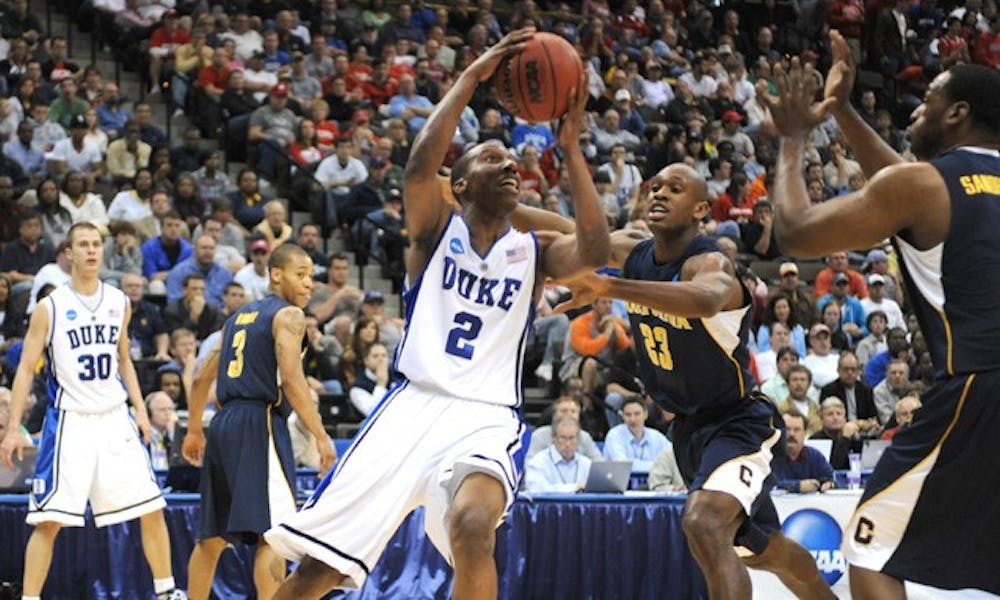Perhaps it took an outsider to really see this Duke team for what it is. In Monday’s San Francisco Chronicle, sportswriter Ray Ratto performed the autopsy on a year of California Basketball shut down decisively by Duke.
“Cal’s season ended because Duke made it end, comprehensively, firmly, slowly but surely,” Ratto wrote. “The final game of this remarkable team ended as though a snake were devouring it—deliberately, and whole.”
The snake simile is a good one, but I’d take a different tack: This Duke team, comprehensively, firmly, slowly but surely, strangles the life out of its opponents like a boa constrictor. Here’s the scouting report on this year’s Blue Devils: They grind the game almost to a halt, execute their half-court offense and prevent you from executing yours. It’s so ugly that it’s beautiful.
In a lot of ways, this Duke team is like a mid-major on steroids. Like a mid-major team, the Blue Devils have no sure-fire NBA lottery picks, no All-Americans, no phenomenal athletes in the starting lineup. Like a mid-major team, they buy into their coach’s message, leave their egos in the dorm room, seem to have fun playing with each other, have a roster dominated by juniors and seniors, know what they do best and stick with it. Put it this way: If this Duke team loses sometime in the next two weeks, it won’t be for lack of effort or attention to detail (unlike another royal blue-wearing top seed).
But unlike a traditional mid-major, this Duke team is made up of McDonald’s All-Americans and guys who will have successful professional careers. Jon Scheyer might not be John Wall, but Ali Farokhmanesh is not Jon Scheyer.
Of the teams with high-end talent, the Kentuckys and Kansases, it is said that they can win playing any style. But Duke isn’t one of those teams. The Blue Devils, like any good mid-major, are at their best when they do it their way—by turning each game into their own particular brand of slugfest.
And recently, they’ve been doing just that. Since losing to Georgetown Jan. 30, Duke has played exactly two games faster than the national average of 67 possessions. One was the loss to Maryland in College Park; the other was a closer-than-it-should’ve-been win at Miami. In every other game, opponents have been forced to play Duke’s game.
But the obvious questions remain: Can the Blue Devils keep it up? Can they force Purdue and St. Mary’s/Baylor into a slugfest? Can they be beaten, like a mid-major, by a team that forces them into a faster-paced game than they’d prefer?
In a single-elimination tournament, anything can happen. Can Purdue (or more likely, Baylor) force Duke to play a faster game and beat them? Yes. Will they? Less likely.
As all those ads on the radio telling me to buy gold always say, “Past performance is not a guarantee of future success.” Still, past performance can be a predictor of future success (in college basketball, at least; I don’t know anything about the global market for precious metals), and Duke’s performance this season predicts a beautifully ugly future. Ken Pomeroy’s projections give the Blue Devils a 62 percent chance of reaching the Final Four and a 32 percent chance of winning the national championship. And it’s not because Duke is the prettiest team in the country, but because it has forced opponents to play its way, the ugly way.
All season long (but especially recently), the Blue Devils have forced their opponents to play their slow-down game by the very effectiveness with which they play it. Of the 16 teams remaining in the Tournament, Duke scores the most points per possession (1.21) and allows the fewest (0.85).
When the Blue Devils’ offense is clicking, it slows the game down by preventing opponents from scoring in transition. Duke’s players turn the ball over on just 16 percent of their possessions (fewer than any team remaining in the Tournament), preventing opponents from scoring quick points off those turnovers. Against California, somewhat famously, Duke turned the ball over just five times. The Blue Devils crash the offensive glass, grabbing almost 40 percent of their missed shots, forcing opponents to stay in the backcourt rebounding and preventing quick baskets off of missed shots.
And when Duke does give them the ball back, opponents have to work for their shots against Duke’s halfcourt defense. Blue Devil opponents’ effective field goal percentage (the normal stat plus a bonus for made 3-pointers) for the season is just 43.8 percent, second-best among teams remaining in the Tournament, and they allow opponents to shoot just 28 percent from 3-point range, best in the country.
“There really was no turning point. It was a steady diet,” Cal forward Theo Robertson said after Duke’s second-round win. “They executed so well.”
These are the Blue Devils. This is what they do. This is what they’ve done all season. They crush the life out of their opponents, like a boa constrictor or a mid-major. They win ugly, but they win.
Get The Chronicle straight to your inbox
Signup for our weekly newsletter. Cancel at any time.

